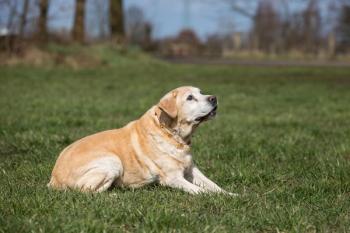
Government may pay student loans for underserved areas
Washington-The government might start paying off veterinary student loans to entice new graduates to work in underserved areas.
Washington-The government might start paying off veterinary studentloans to entice new graduates to work in underserved areas.
The National Veterinary Medical Services Act (NVMSA), which passed boththe House of Representatives and Senate, awaits the signature of PresidentBush. If passed, the United States Department of Agriculture (USDA) hasthe green light to develop a veterinary student loan repayment program forthe "provision of veterinary services in shortage situations."The program is intended to help fill shortages of veterinarians in foodanimal agriculture and inner cities.
If Bush signs it, a separate appropriations bill would follow to spellout the details and dollar amounts of the legislation.
Dr. John Thompson, dean of Mississippi State University's veterinarycollege, was considered instrumental in getting the bill introduced throughRep. Charles W. Pickering, of Mississippi.
How did it all come about?
"The price of education has escalated so much that students arelooking to reduce that amount as quickly as possible after graduation. Itusually makes urban areas much more attractive," Thompson explains.
He thought that giving an incentive to get back to rural areas wouldhelp the veterinarian shortfall.
About five years ago, Thompson broached the subject with Pickering. TheCongressman was sold, and introduced legislation, which slowly gatheredenough support to see its way through Congress.
"The strength of our profession has been built off a foundationof service to the agricultural community and food safety for our country.I personally think it is critical that we keep the best qualified individualsin these areas."
The reality is that fewer and fewer students are choosing food animaland equine as career options.
Thompson explains, "We have more and more people gravitating nationwideto urban settings. We have fewer and fewer people in rural areas that aresupplying our food supply."
Thompson adds that the incentive envisioned by legislation sponsors isnot small either. He hopes the appropriations bill will allow up to threeyears of debt forgiveness.
The fine print
NVMSA allows for veterinary school educational loan repayment assistance(for tuition and educational and living expenses) to veterinarians who agreeto practice in veterinary shortage situations.
The legislation authorizes the Secretary of Agriculture to enter intoagreements (60-day maximum working days during a one-year period) with veterinariansto provide services to the federal government in emergency situations. Theincentive for this service includes loan repayments and a salary for suchservice.
The legislation lets USDA consider debt forgiveness programs for areasvital to the country like public health, epidemiology and food safety.
More interest
Dr. Pat Halbur, associate professor at Iowa State University's veterinaryschool, says the state provided additional ammunition to Congress documentingthe need for this legislation through its 2003 Iowa Food Animal VeterinarianNeeds Assessment Survey sponsored by the Iowa Veterinary Medical Associationand Iowa State University's Department of Veterinary Diagnostic and ProductionAnimal Medicine. The survey results and letters of support were submittedprior to passage of the bill.
Documenting the need
Overall, the Iowa study is thought to be the most comprehensive of itskind looking at food animal veterinary medicine.
Here are some data to shed light on the extent of the problem.
Of the 96 graduates of ISU's 2003 class, only 13 new veterinarians enteredveterinary practice in the state. Only three of the 96 graduates enteredexclusive food animal practice. Of the 13 veterinarians who stayed in Iowa,only four entered food animal practice (including mixed). Overall, 25 ofthe 96 ISU graduates entered mixed practice.
Halbur explains that the shortage of food animal veterinarians is a veryreal phenomenon.
In Iowa, 81 percent of veterinarians feel they will have difficulty inhiring someone to do food animal medicine. The top reason, Halbur says,is the decreased supply of new graduates with a food animal interest.
The survey also sheds light on why this trend is occurring. Lack of interestin food animal medicine was the major reason veterinarians do not pursuefood animal practice. Trends also include a changing gender balance at veterinaryschools and the fact that fewer people in the U.S. population have agriculturalroots.
On the other hand, food animal medicine has traditionally been dominatedby men. The majority of new graduates are now women, and they are choosingsmall animal medicine.
Many food animal practitioners believed that the physical demands andthe late calls in working with agricultural animals were a driving forcebehind the declining numbers of large animal veterinarians. Not so, saysthe Iowa survey. It's a lack of interest. (See Table 1.)
"It was not the physical demands of the job, which many people thinkof as a problem for new graduates," he says.
Of the food animal veterinarians participating in the survey, the biggestdisadvantage to food animal practice is "the unstable farm economy,cited by 44 percent of the respondents. (See Table 2.)
Halbur adds that the study also offers some suggestions on ways to alleviatethe problem including:
· Debt relief legislation
· Early and local recruitment of students with an interest infood animal medicine.
· Influence the public perception of food animal veterinary practitionersby emphasizing: good income, satisfaction with communities they live in,addressing the emerging need, importance of the role in animal health, nationalsecurity, food production and food safety/public health.
The survey also estimates that the state will need at least 120 new foodanimal veterinarians in Iowa in the next five years.
The survey cost the association and school $17,500 to conduct. Ultimately,360 veterinarians participated in the study and were interviewed, achievingan overall response rate of 80.9 percent and an excessively high cooperationrate, Halbur says. "Veterinarians like to talk about this issue."
Newsletter
From exam room tips to practice management insights, get trusted veterinary news delivered straight to your inbox—subscribe to dvm360.




